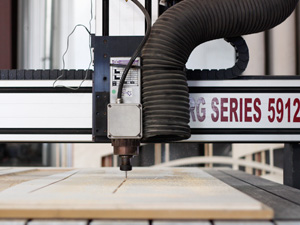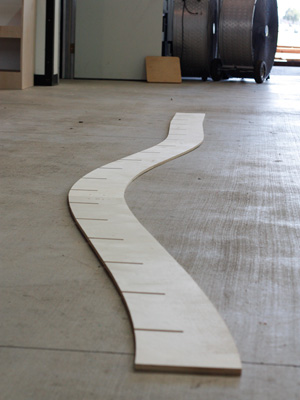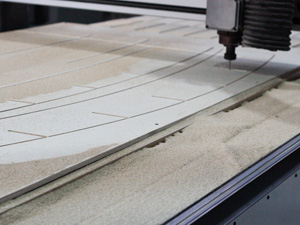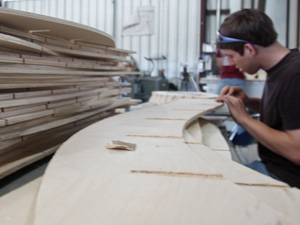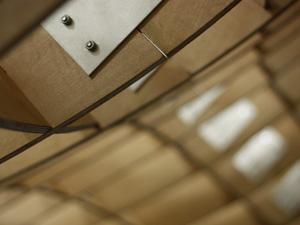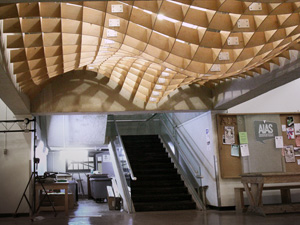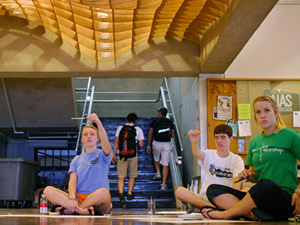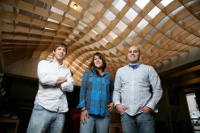


CNC Router
Educational Success Stories
 Affordable Precision Educational CNC Routers Affordable Precision Educational CNC RouterseMail us at technosales@technocnc.com |
|
Texas A & M University Student Installation Gets Wide Acclaim at Texas A&M. As seen in Modern Woodworking, February 2011 Issue - "Student Installation Gets Wide Acclaim at Texas A&M" Techno Inc. recently played a major role in helping a group of Texas A&M architecture students turn their design concepts into reality. The project called "Plywood Mesh #002" started as a small furniture project and evolved into an 18x16-foot sculpture. Article courtesy of Techno Inc. A student-designed and constructed structure made of undulating slices of plywood has received wide acclaim at Texas A&M University. The installation is constructed from interlocking wooden shapes connected by notches and aluminum plates and hung from cables attached to the ceiling. It was designed by three students – Josh Canez, Nick Schaider and Lauren Hensley – from the College of Architecture's Department of Architecture working under the supervision of Professor of Architecture Mark Clayton. The use of advanced digital fabrication methods made it possible for the students to design and build the structure quickly and inexpensively.
"We received an open-ended opportunity from our professor to use digital fabrication for a studio project," Canez said. "Digital fabrication gives you the ability to rapidly produce hundreds of unique pieces. In a little over one semester, we designed and built a project only made possible by the use of a CNC router. This project provides a good prototype of how digital fabrication could be implemented at a building system's scale."
“This project is an example of how digital fabrication acts as an enabler of ideas,” Hensley said. ‘Its added efficiency and higher levels of precision make it possible to produce more complex and interesting forms. High precision components can be produced in a shop at much lower cost than in the past without worrying about the weather. These pieces can be assembled at the site very quickly. Digital fabrication is changing the way that we build – not just sculptures but actual buildings as well. We are grateful that we attend an institution that that supports this technology.” |
"We realized that when you build something at a full scale as a prototype you have to work out the details to a much finer level than when you are simply doing a design project on the boards," Schaider said. "The smallest mistake or inconsistency really stands out when you take the leap from the design board to the real world."
Design and Fabrication Details
The team of students designed the structure with Rhino, first creating a NURBS surface to represent the overall form then using sectioning to cut the surface into individual pieces bi-directionally. The ribs were nested onto sheets of plywood in order to obtain the most efficient use of the material. They used a Techno CNC router to cut out the 99 unique plywood pieces that make up the sculpture to very close tolerances. Only one person was needed on an occasional basis to load and unload the plywood sheets on the CNC router. Assembling the project was like putting together a jigsaw puzzle. "It would have been practically impossible to build this structure using manual methods but with the CNC router it was easy," Canez said.
"Without the router this project would have been nearly impossible because of the huge amounts of time and money required to produce each unique piece manually," Canez added. "The complexity of the ribs made them too difficult to cut by hand. We would have had to make templates and cut each piece with a jigsaw. It's difficult to even estimate the amount of time that would have required."
"I expect this technology will become much more widely used in a range of construction projects especially for ornamental work, high tolerances, expensive materials and highly critical parts," Schaider added. "For those items that are difficult to fabricate, now you can simply cut a profile in plywood. The CNC router will reproduce exactly what the designer has conceived, making it possible to ensure that every piece fits together. The time required for fabrication is substantially reduced because you don't have to spend time making things fit together. We found the machine to be very easy to operate so there was practically no learning curve." |
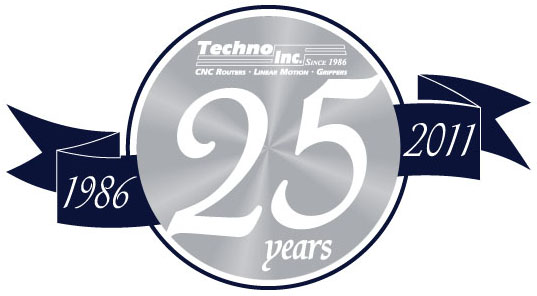 Techno is celebrating over 25 years of CNC technology
expertise. Our Educational sector provides industrial quality products
at educational prices with a network of award-winning Educators. We can
provide CNC Curriculums, CNC Projects, Technical Information and
Packages for any educational classroom.
Techno is celebrating over 25 years of CNC technology
expertise. Our Educational sector provides industrial quality products
at educational prices with a network of award-winning Educators. We can
provide CNC Curriculums, CNC Projects, Technical Information and
Packages for any educational classroom.